
Today we feature the latest guest post from contributing writer Robert Waite, who, thanks to his travelogues from around the world over the course of the past year and a half or so, has helped balloon my own voluminous bucket list to Macy’s Thanksgiving Day Parade proportions.
You can now add Canada’s Jasper National Park to that list. Bob explains why:
By Robert Waite
Jasper, Alberta – I had wanted to visit Jasper National Park pretty much from the time I immigrated to Canada in 1986.
Jasper is the largest and most northerly of seven national and provincial parks in the Canadian Rockies that together form UNESCO’s Canada Rocky Mountain Park World Heritage Site.
Known for its magnificent vistas and abundant wildlife, Jasper had been featured endlessly in the travelogues and magazines of my youth, kindling my imagination.
Twice, in the late 1990’s, I had actually set out to fulfill this mission. The two attempts, by rented vehicle, took place in winter and originated from Lake Louise, 233 kilometers (145 miles) to the south.
Both ended in abject failure. The road between Lake Louise and Jasper is called the Icefields Highway for a reason.
In one instance, it was officially closed a few miles out of town; in the other, under worse conditions, it inexplicably remained open — but my spouse (very explicitly) prevailed on me to turn back.
It is against this backdrop that, as my 70th birthday approached, we made plans to remedy the situation. We would first visit Haida Gwaii, off the northern coast of British Columbia; then, from Vancouver, travel by rail to Jasper.
We opted for the government-run VIA rail service on “The Canadian,” choosing it over the private “Rocky Mountaineer” on the theory that the dome car scenery would be similar and the price far less. More about that in the “If You Go” section.
Peak-A-Boo
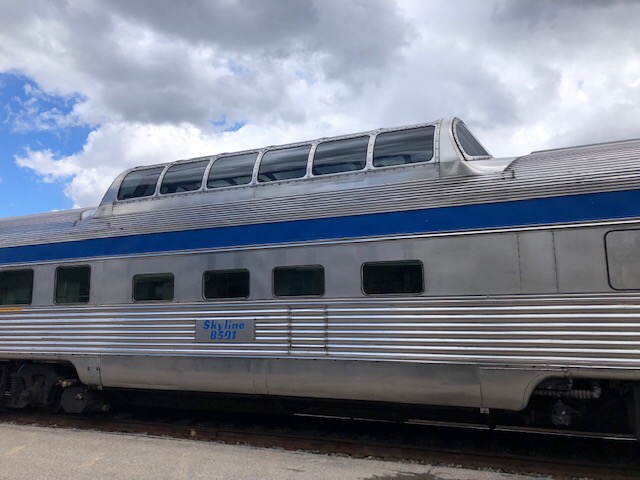
The train ride on either service certainly whets your alpine appetite. By the time you get to Jasper itself you will, weather permitting, already have spied some of the Canadian Rockies’ most magnificent peaks.
You will also have a new appreciation for those brave “navvies who work upon the railroads,” as Gordon Lightfoot croons in “Canadian Railroad Trilogy,” often cited as Canada’s second national anthem.
The town of Jasper, which lies in the heart of the national park along the rail line and at the juncture of two highways, is a friendly, picturesque community of just 5,000 residents. But it offers pretty much everything you need — from restaurants to hiking gear and apparel, groceries and adult beverages.
The real attractions in Jasper National Park, though, lie outside town.
Summer Snow
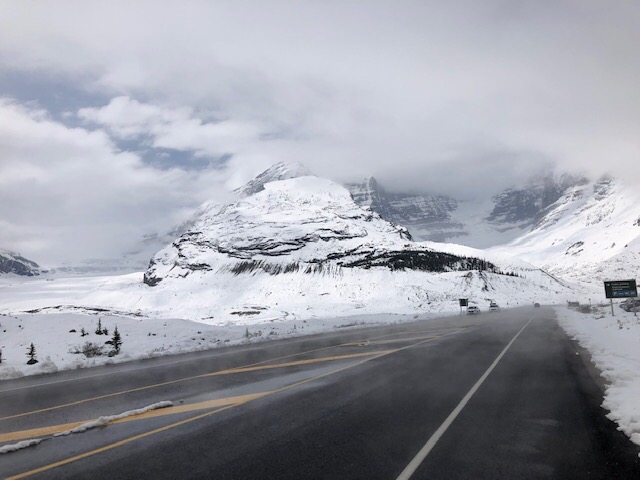
First and foremost are the Columbia Icefields.
We headed there in a rental car on the first day of summer, June 21, and as we gained altitude approaching the icefields we encountered – what else? – snow. It got slippery but was manageable.
The Columbia Icefields Discovery Centre, as it is officially dubbed, is a large modern structure with an exhibit area, restaurants, and kiosks where you can sign up for various tours.
Some of these can take you, by special-purpose vehicle, right up onto the noted Athabasca glacier. Others include a visit to a half-circle, glass-floored structure that hangs off a cliff 280 meters (918 feet) above the valley floor, creating the illusion of being suspended in air.
For Canadian $87 an adult can buy the Columbia Icefield Adventure, which combines both the vehicle ride onto the glacier with the death-defying ambulation.
Fatal Attraction
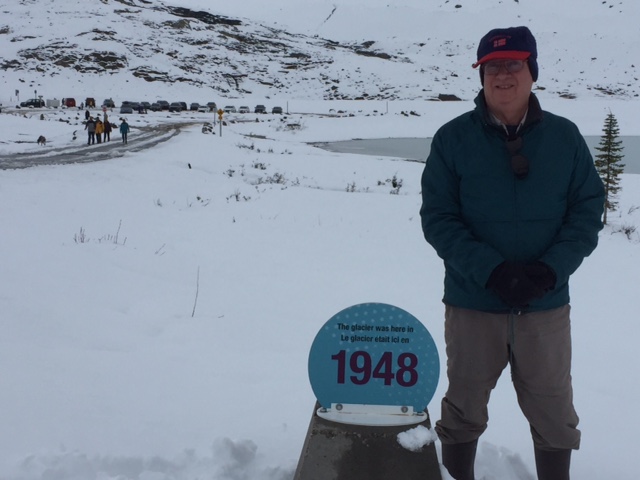
Be forewarned, however: one of these six-wheeled, 25-ton Ice Explorer vehicles took a tumble down the gravelly road leading to the glacier last July, killing four and injuring 14.
As it happened, more out of thrift than safety concerns, we chose to walk to the glacier’s terminus, a reasonably easy hike that takes about 30 minutes one-way.
If you are up to this, you are rewarded by retracing the history of the glacier in reverse. At various points you pass signs telling you that in, say, 1925, the terminus was here; in 1948, it was here; in 1967, there; and so on.
While the markers might not provide definitive proof of global warming, they dramatically bring home the fact that the glacier is receding at an alarming – and accelerating – rate.
The other advantage of walking – beyond the healthy exercise – is that you can actually hear the glacier, which shifts and “moans” from time to time. (You can hear – and sometimes even feel – this even more if you do venture out on a glacier, as I have done in New Zealand).
There’s much to see and do beyond the Icefields as well.
Slot Canyon
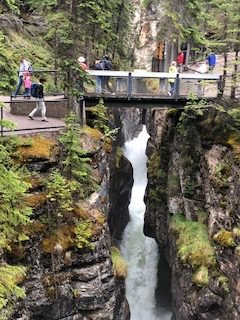
across a series of bridges, with waterfall views.
Photos by Robert Waite.
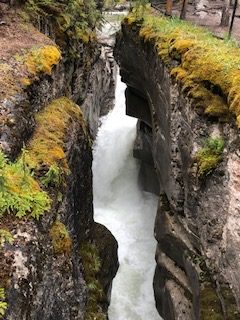
The Maligne Canyon, a perfect example of a “slot” canyon measuring at some points over 50 meters (165 feet) deep, features beautiful swift-flowing falls carving through (and sometimes disappearing into) the surrounding rock.
The most common hike is from the First to the Fifth Bridge and back – it takes about 2 ½ hours and is well worth it. In winter you can also take a guided “Ice Walk” – with proper clothing and ice-busting footwear a must.
Miette Hot Springs features a large outdoor thermal pool where you can relax surrounded by the Rockies (and enjoy even as snowflakes fly above you). This might be just the place to retreat to after hiking the canyon (or just as a reward for being a Boomer).
And if you’re looking for a little more volume and height in a waterfall, Athabasca Falls might be just the ticket. While no Niagara, it does tumble 23 meters (75 feet), with an impressive flow. It is located about 30 km south of Jasper on the west side of the parkway.
At various locations you are likely to see wildlife, including elk, bears, deer and all manner of birds, from hummingbirds to owls, hawks and eagles. A good telephoto lens will be your friend (as will binoculars).
After decades of dreaming about Jasper and two thwarted efforts to reach it, the park fully lived up to my expectations – and when the COVID coast clears, this northern jewel in Canada’s Rocky Mountain crown will be waiting to welcome your visit as well.
If You Go

VIA rail’s “Canadian” leaves Vancouver’s Pacific Central Station at 3 pm. In theory, it takes 19 hours to get to Jasper. In reality, due to freight traffic, it often takes hours longer. We opted for “Sleeper Car Plus” class, which provides a pretty comfortable compartment that converts to two stacked beds.
You also have access to the domed observation car (as do others, so your stay will be limited). The on-board service was excellent; the dining, we found, was better than expected.
For about twice the price you could try the privately operated Rocky Mountaineer, which perhaps has better cuisine and more opulent appointments. But that train, too, often runs behind schedule.
The nearest major airport is located in Edmonton, Alberta — about a four-hour drive from Jasper.
In Jasper we stayed at Alpine Village Cabin Resort, just south of town and located across from the sparkling Athabasca River. While not the cheapest place in town, these modern log cabins are well appointed and include kitchenettes and a separate living room with fireplace. We highly recommend this property.
If you really feel like splurging, the Fairmont Jasper Park Lodge is one of Canada’s great railway-era properties. It’s certainly worth a visit – we had a very nice lunch there and strolled the grounds.
We also enjoyed the Miette Hot Springs Restaurant for lunch – a combination of Greek and local dishes. Plus, there was a hummingbird at the feeder outside our window in the midst of a snow shower!
In the town of Jasper, the Pines restaurant gets consistently good reviews and features local cuisine.
Given that many area sights are out of town, we also recommend renting a vehicle. An Avis Rental Car office is directly across from the Jasper train depot.
We visited during the summer prior to COVID. As vaccines roll out, travel restrictions should eventually be eased, hopefully by the summer of 2021 – but check ahead.
The Columbia Icefields are closed to visitors for winter. The projected opening date in 2021 is May 1.
Author Bio:
Author Bio: Contributing writer Robert Waite has written on travel for nearly 50 years; his previous posts for clarknorton.com include such far-flung destinations as Namibia, Rwanda, Albania, Cambodia (Angkor Wat), Laos, Oslo, and Guatemala. He is also a professor at Seneca College in Toronto and Managing Partner at Waite + Co., a communications consulting firm with offices in Boston, Ottawa and Toronto.
Reader Comments:
nice thoughts and got some ideas from your content.
—Vacation Exchange
thevacationexchange.com
rhondabloo020@gmail.com
Definitely a must see!
—Martha Waite
martha.waite@gmail.com












3 Responses to Jasper: The Canadian Rockies’ Northern Jewel